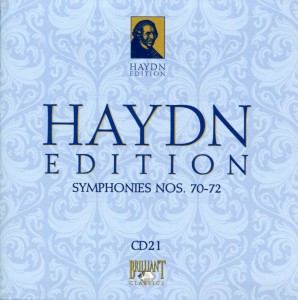 You know the old saying that times flies when you’re having fun?
You know the old saying that times flies when you’re having fun?
Well, it’s not true.
Time flies whether you’re having fun or not, usually when you’re busy as hell and it becomes, as the late MacDonald Carey used to say at the start of each Days of Our Lives episode, “like sands through the hourglass.”
The older we get, the more those sands fall to the bottom of said hourglass.
I type that because three weeks have already passed since I started this three-year project. I have no idea where those 21 days went. Tell you what, though, if I could stick my finger in that little narrow tube between the top of the hourglass and its bottom I most definitely would. (Hmm, the words “stick my finger in” and “its bottom” in the same sentence don’t necessarily enhance the appeal of this morning’s Asiago bagel. But you know what I mean. )
Symphony No. 70 in D is another delightful composition, one that grabbed me from the opening Movement. It’s slightly reminiscent of one of those old news/interview programs from the 1960s, like Meet the Press or Face the Nation or whatever they’re called. (Are they still around?) Lots of syncopation. Timpani. An air of importance or seriousness.
According to its entry on Wiki, the first symphony on Haydn CD 21,
…was written by Joseph Haydn to mark the start of construction of a new opera house on the Eszterháza estate. It was premiered on December 18, 1779 — one of the few Haydn symphonies where the exact premiere date is known.
Stuff like that interests me. The exact premiere date. Now I know that on December 18th of this year, this symphony will be exactly 234 years old.
Now, I’m no musicologist. But I’ll bet you dollars to donuts we won’t be celebrating Ke$ha’s “TiK ToK” in 234 years. Frank’s “Come Fly With Me,” maybe. Sammy’s “Birth of the Blues,” perhaps. Dino’s “Everybody Loves Somebody,” sure. But, “TiK ToK”? (Can you imagine if we put that song in a time capsule with instructions to open it in the year 2247? The people from that star date would never forgive us.)
Movement II ( the improbably named “specie d’un canone in contrapunto doppio: Andante”) is interesting, if excruciatingly slow. It’s not altogether unpleasant. But it’s not exactly making people around me say, “I’ll have what he’s having.”
Haydn’s third movement, a typical “Menuet & Trio,” is catchy. But not gripping.
Movement IV (“Finale: Allegro con brio”) is quirky. Loud soft. Loud soft. Dancing violins. All instruments join. Building. The ending is really interesting. Tiny little violins squeaking dee-dee-dee-dee-dee…a bit of silence…then all instruments DA-DA-DA-DA-DA. Then it ends.
By the way, Haydn was 47 when he premiered this symphony. I wonder what life was like in Austria for a 47 year old. Or how his symphony was received. Was it a smash hit? Was Haydn boffo?
Symphony No. 71 in B Flat was composed in 1780.
No. 71 is serious. And heavy. It opens with DAHH-DAHH-da-da-da. Low notes. Then, the violins start a happier dance around the heaviness, pulling the symphony into a kind of methodical exploration of tones, textures, and melodies. Or, as someone put it on Wiki,
After dark string sonorities reminiscent of Sturm und Drang in the slow introduction, the Allegro begins with a very light galante theme which is interrupted periodically by more darkly colored strings. The transitional material is notable for its use of counterpoint.
I’m not sure I heard anything like this during Haydn’s Sturm und Drang period. This is different. More complex. Perhaps its because I’m now hearing a 48-year-old Haydn, not some angsty young guy who’s the musical equivalent of Marlon Brando. (I think that’s what I’ll picture in my head when I think of Sturm und Drang — Brando, circa On the Waterfront or A Streetcar Named Desire, clutching his face and screaming “Stella!”)
Once again, it’s the last Movement (“Finale: Vivace”) that steals the show for me. Nice horns. Powerful timpani. It’s stirring.
Symphony No 72 in D was composed between 1763 and 1765, which — as it noted in its entry on Wikipedia — is not well placed in Haydn’s chronology. Why it is numbered here is a mystery to one and all.
This is my least favorite symphony on today’s CD, probably because it’s a throwback to the kind of Haydn symphonies that sounded too much like the musical equivalents of a board meeting in a bank — sedate, stately, safe. I picture David Tomlinson, as Mr. Banks in Disney’s Mary Poppins, listening to this symphony.
I’m more of a Bert the Chimney Sweep kinda guy.

There’s a lot to be said for Bert the Chimney Sweep. Seems to me he had his priorities in line.
Yeah, he definitely had a sense of play about him, didn’t he? Hell of a dancer, too. (Although his Cockney accent needed a bit of work.)
Hopefully, the future will either forget, or forgive us for unfortunate music like Ke$ha. Then again, if the music played in Mos Eisley in Star Wars is any indication, music in the future might not be much to write home about, either.